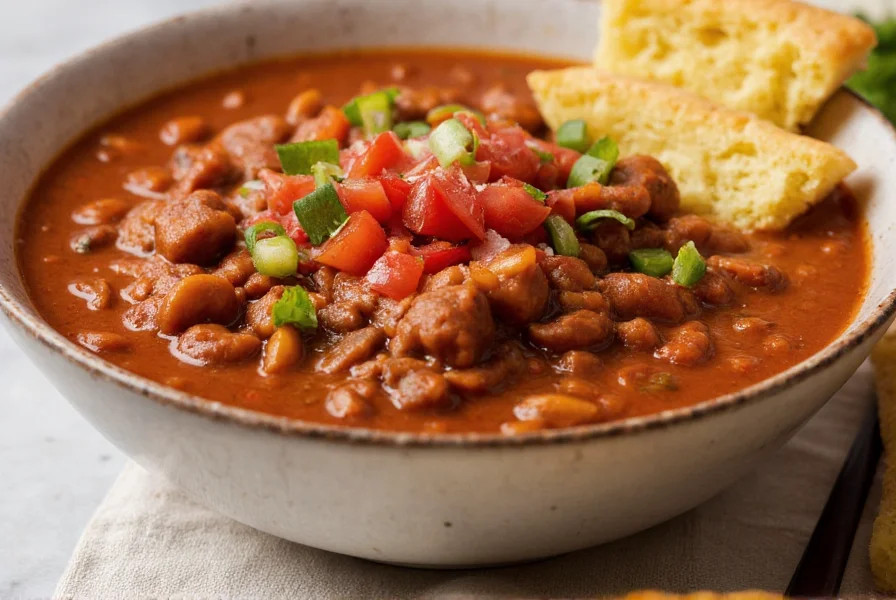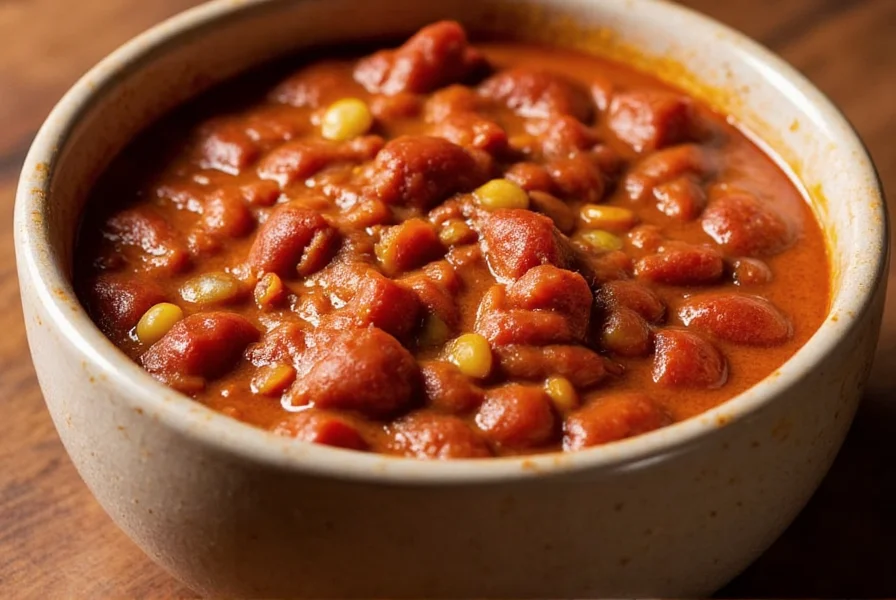
What Truly Makes the World's Best Chili
When chili enthusiasts debate the "world's best chili," they're not just arguing about heat levels. The most exceptional chili recipes balance multiple flavor dimensions while showcasing technical cooking precision. Based on decades of championship cooking and culinary expertise, the finest chili achieves harmony between meat richness, spice complexity, and subtle background notes that emerge through proper technique. Unlike ordinary chili recipes that simply throw ingredients together, award-winning chili follows specific principles that transform simple components into something extraordinary. The difference between good chili and the world's best chili lies in attention to detail at every stage of preparation.The Essential Components of Championship-Winning Chili
Meat Selection and Preparation
The foundation of exceptional chili starts with meat quality and proper preparation. Traditional Texas-style chili, which dominates competition circuits, uses only meat—typically beef chuck or brisket cut into 1/4-inch cubes. Ground beef creates a different texture profile that most judges consider inferior for championship chili. Proper browning is critical—each piece should develop a deep sear without stewing in its own juices. This Maillard reaction creates complex flavor compounds that form the backbone of great chili. Never overcrowd the pan; work in batches if necessary to ensure proper caramelization.The Great Bean Debate
In authentic "world's best chili" competitions, beans are almost always prohibited. The International Chili Society, which sanctions major competitions worldwide, explicitly bans beans in their championship categories. Traditionalists argue that beans dilute the pure meat-and-spice experience that defines true chili. That said, regional variations exist. Cincinnati-style chili often includes beans, while New Mexico chili focuses on roasted chilies rather than meat. Understanding these distinctions helps you appreciate why "best" is context-dependent.| Chili Style | Key Characteristics | Bean Usage | Signature Ingredients |
|---|---|---|---|
| Texas Red | Meat-forward, rich broth | No beans | Beef, ancho & guajillo chilies |
| Cincinnati | Sweet-spiced, spaghetti topping | Often includes beans | Cinnamon, allspice, cocoa |
| New Mexico | Chile pepper dominant | Rarely includes beans | Roasted green or red chilies |
| Midwest | Tomato-based, hearty | Commonly includes beans | Tomatoes, kidney beans |
Spice Profile and Balance
The world's best chili recipes feature a carefully calibrated spice blend rather than simply maximizing heat. Professional chili makers emphasize "flavor heat" over "burning heat," achieved through:- Using fresh, high-quality chili powders (never old spices from the back of your cabinet)
- Toast whole spices before grinding for maximum flavor release
- Layering different chili varieties for complexity (ancho for fruitiness, guajillo for earthiness, cayenne for heat)
- Adding complementary spices like cumin, oregano, and a touch of cocoa or coffee
The Championship Chili Recipe Framework
While exact recipes are closely guarded secrets among top chili cooks, the following framework represents techniques used in award-winning chili recipes:Essential Ingredients
- 2.5 lbs beef chuck, cut into 1/4-inch cubes
- 3 tbsp vegetable oil
- 4-5 cloves garlic, minced
- 2 medium onions, finely diced
- 3 tbsp ancho chili powder
- 2 tbsp guajillo chili powder
- 1 tbsp cumin
- 1 tsp Mexican oregano
- 1/2 tsp cayenne (adjust to taste)
- 1 cup strong coffee or dark beer
- 1 cup beef stock
- 1 tbsp unsweetened cocoa powder
- 1 tbsp apple cider vinegar
- Salt to taste
Step-by-Step Preparation
- Prepare the meat: Pat beef cubes completely dry and season generously with salt. Working in batches, sear meat in hot oil until deeply browned on all sides. Remove and set aside.
- Sauté aromatics: In the same pot, cook onions until translucent, then add garlic and cook for 1 minute more.
- Bloom spices: Add all dry spices to the pot and cook for 1-2 minutes until fragrant, stirring constantly to prevent burning.
- Build the base: Return meat to pot along with coffee/beer, beef stock, and cocoa powder. Bring to a gentle simmer.
- Slow cook: Cover and cook on low heat for 3-4 hours, stirring occasionally. The chili should never boil vigorously.
- Finish: Stir in apple cider vinegar 15 minutes before serving. Adjust salt and spice levels as needed.
Advanced Techniques for Perfect Chili Every Time
The Importance of Time and Temperature
True championship chili requires patience. The minimum cooking time for authentic world-class chili is three hours, with many experts recommending four to six hours of gentle simmering. This extended cooking time allows:- Collagen in the meat to break down into gelatin, creating a rich mouthfeel
- Flavor compounds to fully integrate and mellow
- Spice elements to harmonize rather than compete
Secret Ingredients That Elevate Flavor
While traditional chili uses straightforward ingredients, many award-winning recipes include subtle additions that create complexity:- Dark chocolate or cocoa powder: Adds depth and balances acidity without making chili taste sweet
- Coffee or espresso: Enhances meat flavors and adds subtle bitterness that complements spices
- Liquid smoke (sparingly): For that authentic wood-fired flavor when cooking indoors
- Marmite or Worcestershire sauce: Provides umami depth that makes chili taste "meatier"
- Orange or lime zest: Brightens heavy flavors with citrus oils
Serving and Storage Tips for Peak Flavor
Chili often tastes better the day after it's made, as flavors continue to meld. For optimal results:- Cool chili completely before refrigerating
- Store in airtight containers for up to 4 days
- Reheat gently on the stove, adding a splash of water or broth if needed
- Top with fresh ingredients like diced onions, cilantro, or a dollop of sour cream

Frequently Asked Questions
How can I make chili less spicy without losing flavor?
Add acidity rather than dairy to balance heat. A tablespoon of lime juice or apple cider vinegar per serving brightens flavors while reducing perceived spiciness. You can also stir in a small amount of honey or maple syrup to counterbalance heat with subtle sweetness. Adding more meat or broth dilutes flavor, so these should be last-resort options.
Why does my chili taste bland even with lots of spices?
Bland chili usually results from using stale spices or failing to bloom them properly. Always toast whole spices before grinding, and replace chili powders every 6 months. The critical step many miss is "blooming" spices in oil—cook them for 1-2 minutes in the pot after sautéing onions but before adding liquids. This releases essential oils and dramatically intensifies flavor.
Can I make authentic chili in a slow cooker?
Yes, but with modifications. First sear meat and bloom spices on the stove, then transfer to slow cooker. Cook on low for 6-8 hours. The slow cooker's gentle heat works well for tenderizing meat, but lacks the surface area for proper evaporation, so you may need to finish on the stove to thicken the chili to ideal consistency. Never put raw meat directly in a slow cooker for chili—it won't develop the necessary fond for deep flavor.
What's the difference between chili powder and chili seasoning?
Chili powder is primarily ground dried chilies, sometimes with minimal additives. Chili seasoning typically contains chili powder plus additional ingredients like garlic powder, cumin, and salt. For authentic world-class chili, use pure chili powders (ancho, guajillo, etc.) rather than pre-mixed seasoning to control the exact flavor profile. Commercial seasoning blends often contain fillers and excessive salt that prevent proper flavor balancing.
How do professional chili cooks achieve such rich color?
The deep, rich color comes from properly seared meat and toasted spices, not from tomato products. Many competition chili recipes contain no tomatoes at all. The key is developing fond (browned bits) through proper meat searing, then deglazing the pot thoroughly. Using multiple types of chili powders—particularly ancho for its deep red color—also contributes to the signature rich hue without making the chili taste tomatoey.











 浙公网安备
33010002000092号
浙公网安备
33010002000092号 浙B2-20120091-4
浙B2-20120091-4